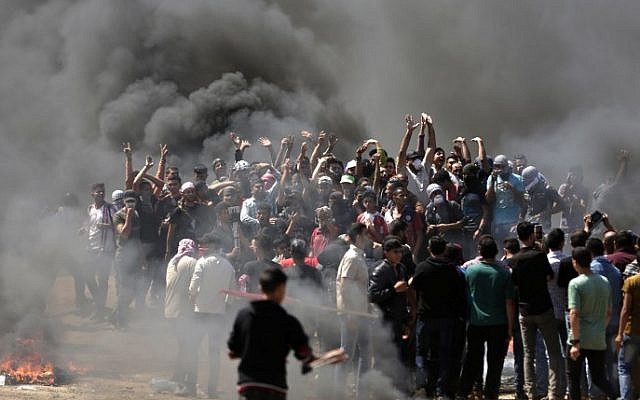By Christina Chu
Recent events in the Gaza Strip have demonstrated an increase in the scale of violence in the 70-year ongoing conflict between Israeli forces and Palestinians living in the area. Planned, peaceful, six-week demonstrations have begun, with support from various sectors of the Palestinian community, including Hamas, the militant political party that controls the Gaza Strip, families who have come to protest the conditions in Gaza, and anti-Israel factions, including the Popular Front for the Liberation of Palestine, a hard-line group responsible for aircraft hijackings in the 1960s and 1970s.
These protests, called the “Great March of Return,” represent a fresh approach to the Israeli-Palestine conflict, with cultural events, protest camps, and traditional dabke dancing scheduled to draw attention to the conditions in Gaza and the plight of Palestinians who have been exiled from their ancestral homes in Israel. Since Israel declared independence on May 14, 1948, Palestinians living in that newly independent territory were expulsed from their historical homes, and this forced eviction has become the central cause of Palestinian discontent with the Israeli state, leading to arguments that fight for ‘right of return’ and highlight the discrimination and maltreatment experienced as a result.
Beginning on March 30, 2018, thousands of protestors began moving towards their homes in commemoration of Land Day, the annual tribute to the March 1976 confiscation of land and expulsion of Palestinians by Israel that resulted in six deaths and over a hundred injuries. Land Day, or Yom-Al Ard, has become a day where demonstrations are held to mark this loss of land to Israel and to protest discrimination and human rights violations occurring in Gaza.
However, this year, Land Day demonstrations were the beginning of a much larger movement and the response by Israeli forces were violent, including dispersion tactics like tear gas, rubber coated steel pellets, and live gunfire.
While women and children participated in protest camps several hundred meters from the Gazan border with Israel, other crowds neared the boundary, throwing rocks and rolling burning tires, which incited Israeli forces to engage and fire live ammunition into the crowds. In the bloodiest episode in years, Gazan hospitals recorded several hundred patients seeking treatment for injuries related to the protests, with doctors saying most were gunshot wounds.
While the exact number is disputed, many sources agree that around fifteen people were killed and over 750 wounded in the mass demonstrations. Palestinian president, Mahmoud Abbas, declared Saturday, March 31, 2018 a national day of mourning in response to those killed. Although Abbas does not support Hamas control of the Gaza Strip region, he does support the goals of peaceful protestors who seek their right of return under international law.
These peaceful protestors have been organized by a man by the name of Ahmad Abu Artema, who claims no affiliation to Hamas and says he wants peaceful resistance and to see Palestinians and Israelis living together as equal citizens. Artema’s personal opinion is that the apartheid-like system of separation between Israelis and Palestinians should end, resulting in the cohabitation of one state by the two groups. He hopes that this new non-violent movement will change the perception of the pro-Palestine community.
Despite the violent demonstrations at the border, most participants stayed peaceful and refrained from approaching the border, an area which is known to be a hostile military zone. People have been warned to stay away from the border area, but Israel claims that several people have tried to cross through, cutting holes in the fence, prompting a swift reaction to stop them.
Israel’s defense minister, Avigdor Lieberman, maintains that Israeli action was justified, telling Israeli Army Radio: “I think that all of our troops deserve a commendation, and there won’t be any inquiry.” Israeli forces say they responded only to violent attacks aimed at them and the border fence, but some accounts report differing information, including video footage of one man being fatally shot in the back while running from the border area with a tire.
The Israeli military argues footage is either incomplete, edited, or entirely fictitious, accusing Hamas of releasing recordings to skew public opinion. They also claim that those killed were men involved in the violence and who belonged to Hamas or other militant groups. Lieberman stands by statements that those protesting peacefully were not injured in the conflict.
Israeli UN ambassador, Danny Danon, says the peaceful marches are simply cover for “a well-organised and violent terror-gathering” and that the Palestinians used the timing of the Passover to take advantage of Israel’s temporary absence at the UN due to its observance of the Jewish holiday.
However, Palestinian ambassador, Riyad Mansour, has expressed his disappointment in the lack of international resolve to condemn the violence, calling the events a “heinous massacre” of peaceful demonstrators.
Although it did not take any concrete action, the UN Security Council did urge restraint from both sides in an emergency meeting convened by Kuwait hours after the bloodshed. Important leaders have also called for independent, transparent investigations into the violence, including UN Secretary-General António Guterres and EU’s top diplomat, Federica Mogherini, but Lieberman has refused these requests, saying Israel will not cooperate with a UN inquiry if there were one.
Israel has also promised an expanded response if clashes continue, and Israeli forces are prepared to target militant groups within the Gaza territory if violence at the border resumes. Protests are scheduled to culminate on May 15, 2018, marking 70 years since Israel’s 1948 founding, with a large border march, so it is unlikely that violence will subside.
In the next six weeks, demonstrations may lead to continued, intense violence, or the international community may step in and take stronger action against one side. For now, however, tensions will remain high as each side disputes the responsibility for the conflict, and neither is willing to concede.
